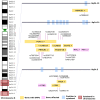The landscape of 8q24 cytoband in gastric cancer (Review)
- PMID: 38464340
- PMCID: PMC10921260
- DOI: 10.3892/ol.2024.14311
The landscape of 8q24 cytoband in gastric cancer (Review)
Abstract
Worldwide, gastric cancer (GC) is estimated to be the fifth most common type of cancer type in both sexes, ranking sixth for new cases, with >640,850 cases per year, and fourth in terms of mortality rate. Cancer presents numerical and structural alterations in chromosomes, often through gains and losses of regions. In GC, there are multiple genetic alterations, in which those located in cytoband 8q24 have been frequently described; essential genes are present in this cytoband, regulating the homeostasis of crucial biological processes, such as the MYC gene, which induces expression of selective genes to promote cell growth and proliferation. Conversely, DNA sequence variations can also occur when a single nucleotide in the genome sequence is altered, and this is termed a single nucleotide polymorphism (SNP). These alterations, which can serve as a biological marker, are present in at least 1% of the population and assist in identifying genes associated with GC. In the present review, 12 genes present in cytoband 8q24 related to GC (NSMCE2, PCAT1, CASC19, CASC8, CCAT2, PRNCR1, POU5F1B, PSCA, JRK, MYC, PVT1 and PTK2) are discussed. The PSCA gene was cited more frequently than others; it has four known SNPs associated with GC (rs2978980, rs2294008, rs2976392 and rs9297976). Thus, these SNPs should be further studied in different populations to determine their risk value in patients with GC.
Keywords: 8q24; cytoband; gastric cancer; genes; single nucleotide polymorphism.
Copyright: © 2024 Larios-Serrato et al.
Conflict of interest statement
The authors declare that they have no competing interests.
Figures


Similar articles
-
Association of rs2294008 and rs9297976 Polymorphisms in PSCA Gene with Gastric Cancer Susceptibility in Uzbekistan.Cent Asian J Glob Health. 2016 Dec 13;5(1):227. doi: 10.5195/cajgh.2016.227. eCollection 2016. Cent Asian J Glob Health. 2016. PMID: 29138729 Free PMC article.
-
Long non-coding RNA polymorphisms on 8q24 are associated with the prognosis of gastric cancer in a Chinese population.PeerJ. 2020 Feb 21;8:e8600. doi: 10.7717/peerj.8600. eCollection 2020. PeerJ. 2020. PMID: 32117633 Free PMC article.
-
Association of high-evidence gastric cancer susceptibility loci and somatic gene expression levels with survival.Carcinogenesis. 2017 Oct 26;38(11):1119-1128. doi: 10.1093/carcin/bgx090. Carcinogenesis. 2017. PMID: 29028942 Free PMC article.
-
Evolution of the concept of androgen-sensitive bladder cancer.Scand J Urol. 2013 Jun;47(3):173-8. doi: 10.3109/00365599.2012.756929. Epub 2013 Jan 21. Scand J Urol. 2013. PMID: 23330817 Review.
-
Review: Single nucleotide polymorphisms associated with the oncogenesis of colorectal cancer.Surg Today. 2012 Feb;42(3):215-9. doi: 10.1007/s00595-011-0038-z. Epub 2011 Nov 30. Surg Today. 2012. PMID: 22127532 Review.
Cited by
-
Upregulation of long noncoding RNAs LINC00941 and ABHD11-AS1 is associated with intrahepatic cholangiocarcinoma.Sci Prog. 2025 Jan-Mar;108(1):368504251330019. doi: 10.1177/00368504251330019. Epub 2025 Mar 28. Sci Prog. 2025. PMID: 40151866 Free PMC article.
-
HPV, HBV, and HIV-1 Viral Integration Site Mapping: A Streamlined Workflow from NGS to Genomic Insights of Carcinogenesis.Viruses. 2024 Jun 18;16(6):975. doi: 10.3390/v16060975. Viruses. 2024. PMID: 38932267 Free PMC article.
-
Association between the PSCA rs2976392 polymorphism and susceptibility to gastric cancer: a meta-analysis.Front Genet. 2025 Jul 16;16:1618597. doi: 10.3389/fgene.2025.1618597. eCollection 2025. Front Genet. 2025. PMID: 40741413 Free PMC article.
References
-
- Global Cancer Observatory. 900 World Fact Sheet. https://gco.iarc.who.int/media/globocan/factsheets/populations/900-world.... [ February 22; 2024 ];
Publication types
LinkOut - more resources
Full Text Sources
Miscellaneous
